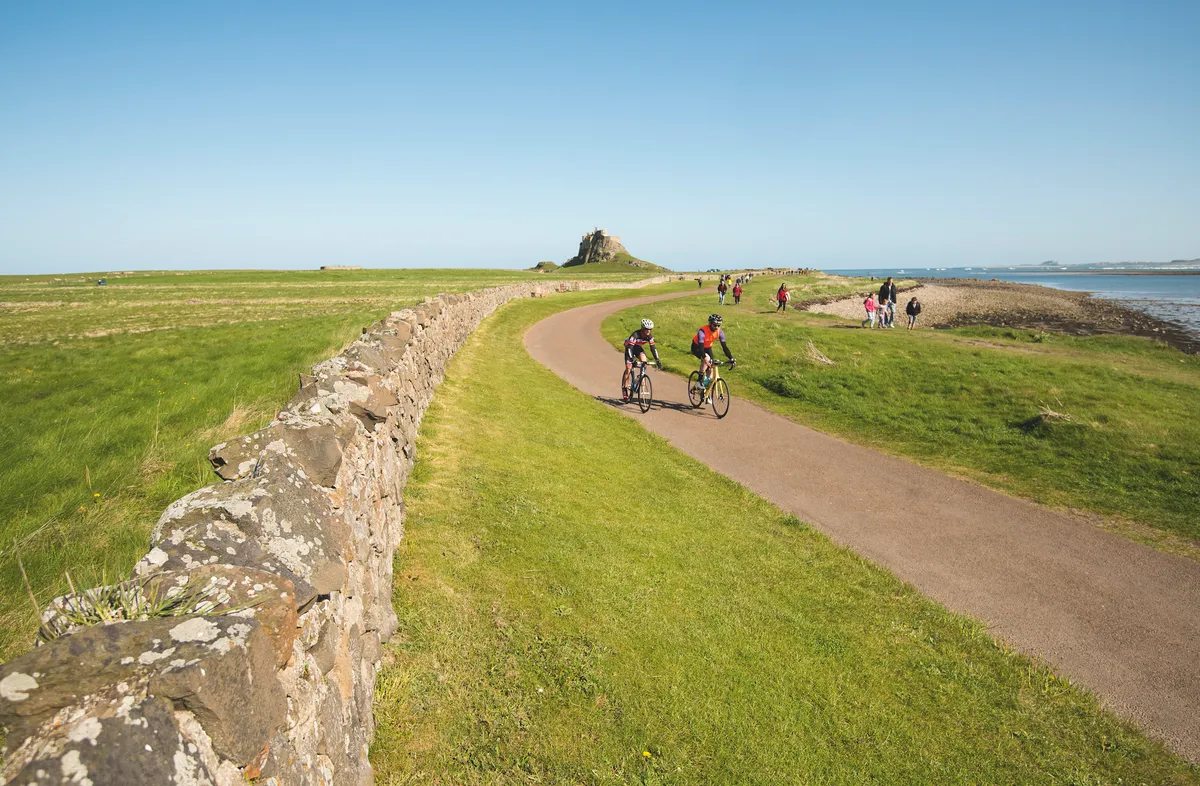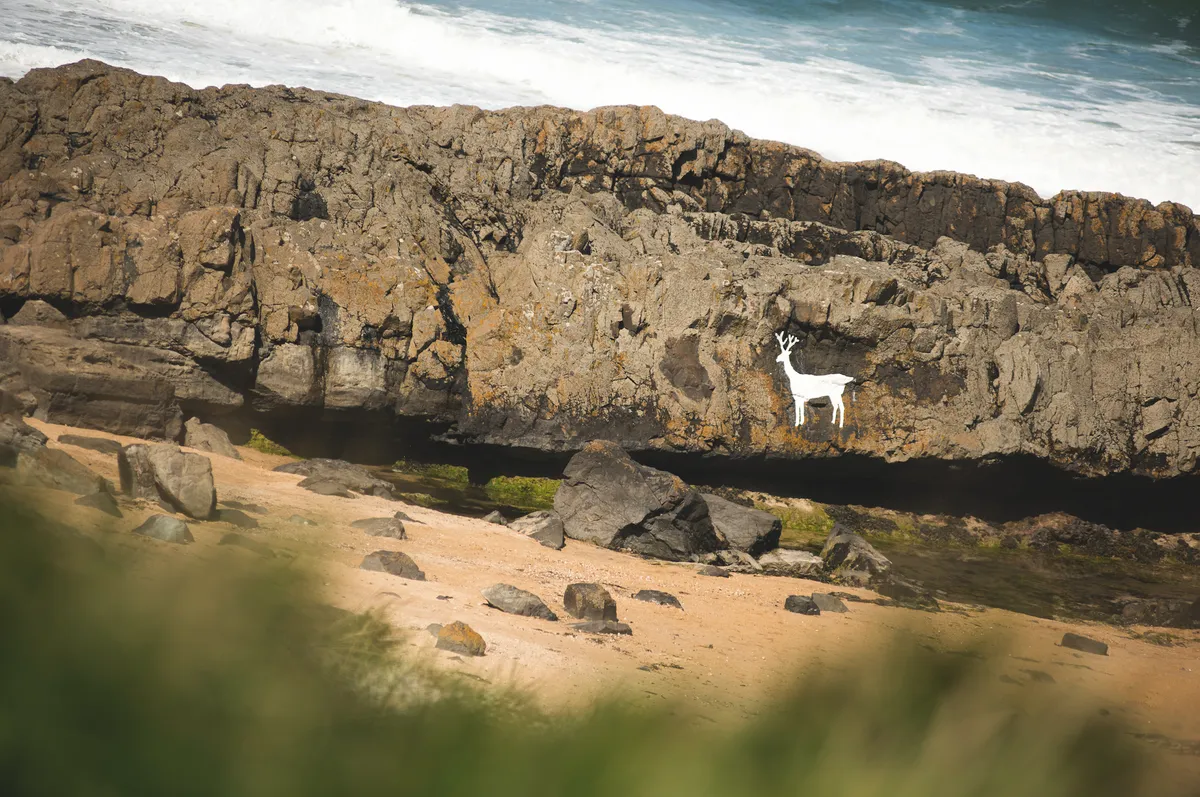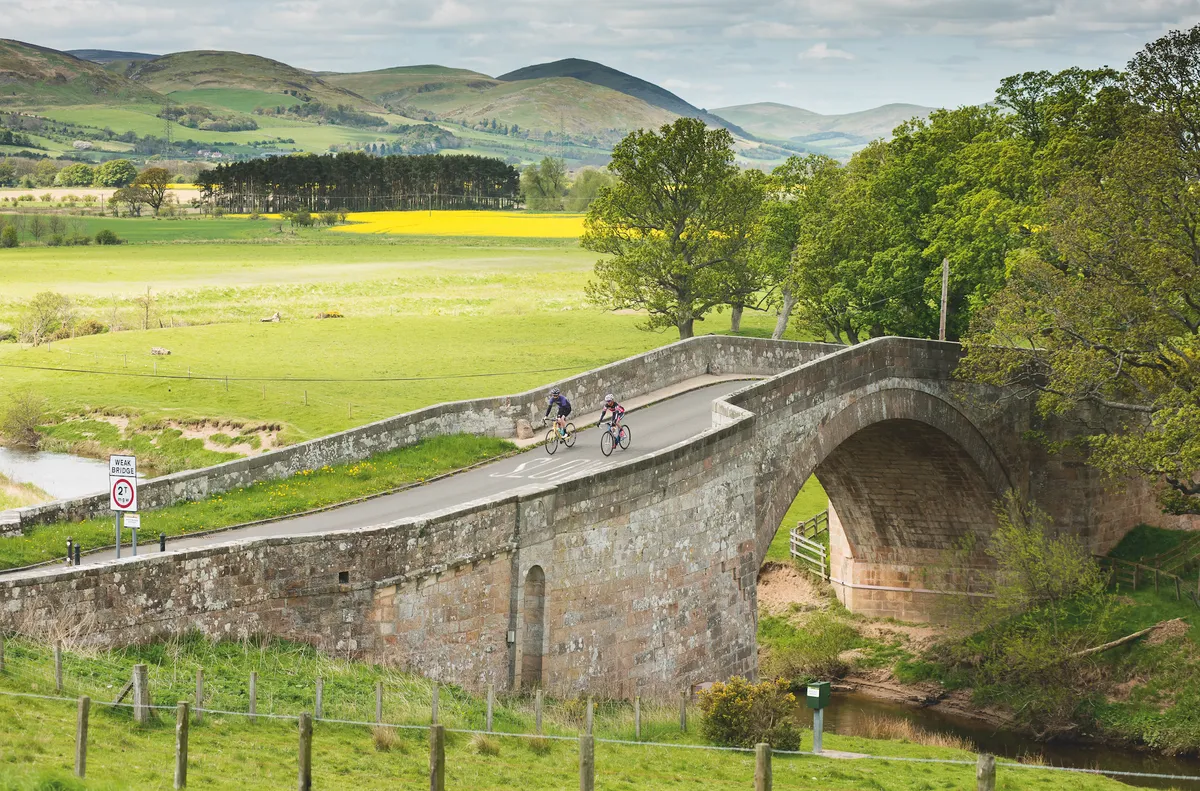Ride Information
- Distance: 57 miles (92km)
- Grade: Moderate: gentle undulations add up to a surprisingly high total ascent and there are a couple of steeper climbs. Winds can be a big challenge, though.
- Download the route here
It’s great to be rolling. Despite the sun blazing down from a cloudless sky into the car park of the Lindisfarne Inn, the wind belting in off the North Sea felt as though it was bypassing Lycra, hair and skin and striking our bones directly. However, as the noisy A1 subsides behind us and a gentle incline opens up alongside fields of golden waves of rapeseed, warmth begins to flow around us and we can turn our attention back to the task at hand.
Even Rich Rothwell, proud Northumberlander and endurance expert, is moved to cautiously admit that it was “fairly cold” during the ubiquitous pre-ride faff. A former professional surfer, he’s quick to point out that the surf brought in by the same winds on to the coastline disappearing behind us is among the best and most under-advertised in the UK.
CASTLES IN THE AIR
We hatched a plan at the inn last night and after some GPS fiddling we’re convinced we can make it work – take in three of the area’s historic and most picturesque castles in one big pedal. Like the surf Rich has just told me about, the area seems to hold more surprises the more you look into it.
Bone dry, the roads we’re now riding on are pretty much the perfect British B-road: virtually traffic-free, reasonably smooth and with enough bends and undulations to hold your interest. A sequence of naturally bermed corners opens out of nowhere and we’re soon carving down towards a neat little hamlet of red-brick houses sheltered from the winds in a dip.
The countryside opens up again with its upper reaches punctured by large, toothy crags of rock. Legendary among the climbing fraternity, they offer a uniquely adhesive form of sandpaper-like granite perfect for bouldering.

We roll on through the village of Lowick, one of the few places to grab supplies if needed on our planned route. Though after a quick chat it’s decided that we’ve more than enough food and water on board. The village shop is all-but invisible behind a sea of bikes leaning against it as participants in the local Wooler Wheel sportive come in for an emergency pit stop.
We continue back out into the rolling countryside and pass handfuls of friendly sportive riders before a fast descent and a humpback bridge, whose narrowness made us focus, leads us back on to a main road and up one of Rich’s favourite local climbs. I’m giving away 20kg and about five Pantone shades in suntan to Rich so I let him set the pace and nudge my BMC into the smaller chainring. The smoothness of the newer, better-maintained asphalt makes the climb feel easier than it probably ought to as the grassy slope to our left drops down steeply to a brook.
Rich has an off-road excursion planned and as the sizeable redbrick houses of Fenton blip by, the road eventually crumbles to little more than a track. I cautiously bunny-hop the potholes as there’s no let-up in the speed before Rich eventually pulls to a halt beside a gate leading into a cycle-path that will eventually reconnect us back to a main road.
The temperatures have increased and the prospect of a mid-ride ice cream seems just about the best idea of the day so far. We roll through the ominously quiet farmyard of the Doddington Dairy, past a pair of big and dusty Massey Ferguson tractors.
“There’s an honesty box over here…” says Rich, heading for an old-fashioned handcart. A full-sized, slightly cracked and damaged fibreglass Friesian eyes our approach. Disappointment has never felt more cutting, however, as due to flagrant spate of dishonesty, the honesty box is no more. Crushed and ice cream-less, we remount and are left to pedal off considering man’s basic inhumanity towards his fellow man.

THE FIRST GLIMPSE
“Yeah, yeah… I can just about see it if I sort of squint between that horse’s nether regions.” This hasn’t been quite the glorious spectacle that we had conceived over dinner last night. After the ice cream debacle it actually feels more like a double kick in the stones. The horse in question is (thankfully) part of a greening metal statue and what we can just glimpse, far in the distance, between its rear legs are the grey ramparts of Chillingham Castle, reputedly Britain’s most haunted and number one in our proposed trio of castles.
Closed for the day, we’re relegated to ogling its turrets from afar but more impressive/intimidating than its ghouls are the local cattle. No one knows exactly where the Chillingham cattle came from but it’s believed they are direct descendants of the wild cattle that once roamed Britain’s forests. There are around 100 in total now, feral and tooled-up with mighty horns. Unfettered by man, they roam the enclosed park between the badlands of Bamburgh and Alnwick with a notoriously confrontational temperament. It’s decided that it is time to move on, quickly.
The freshening wind turning our cheeks red is a sign that we have turned the corner and are on our way back towards the North Sea. The roads approaching Bamburgh are still very much on the B-road spectrum but they feel faster thanks to our warmed legs and the menace of a marauding herd of disgruntled prehistoric bovine not that far behind us. Rich and I take turns at trying to tap out a pace as road markings and an increase in traffic arrive with views of the sea as we roll through the small town of Belford. We’re now heading for Bamburgh and our second castle of the day.

CHILLY CHILLINGHAM
If Chillingham was of the ‘haunted house’ variety of fortified dwelling then Bamburgh is straight from the ‘no chance of invasion here’ book. As with the bulls, its origins predate recorded history but after having been totalled by the Vikings, Bamburgh was rebuilt by the Normans and has been plundered, besieged, fortified and added to pretty much ever since. The Grade 1-listed building casts an imposing shadow from high up on its rock as we park the bikes and clip-clop in our cleats into the Wyndenwell Cafe. Within its cosy confines we slowly drain our coffees and play with the remaining cake crumbs as, despite the cloudless sky, tourists scrabble outside for jacket sleeves and clutch hats to their heads.
By now the wind is making it hard for me to keep my front and rear wheels in line as small particles of sand blast my fingers. Rich traces out submerged coves and surf breaks along the beach but can’t explain a mysterious white stag painted on one of the rocks, which has apparently been there for years.
Suitably blasted we make our way back inland and re-cross the scarily fast A1 before tracking the coastline north again towards our final destination. It’s one of the big failings of the route and one that we had no choice but to make; there simply isn’t a rideable route in between the A1 and the coast back towards Lindisfarne. Given the sheer amount of tourist footfall and traffic the area receives, it seems crazy not to show off such a stunning section of coastline.
CRAGGY ISLAND
Lindisfarne, or Holy Island as it’s equally well known, is located a mile from the mainland and is a tidal island. The long, flat causeway spin is made quite eerie by the remnants of seaweed and sand on the edges of the broken tarmac. We churn our way out, into the wind, towards the towering rock atop of which sits Lindisfarne Castle. The road bends to the right gradually and is punctuated only by small refuge huts on stilts. Old and battered-looking they may be, but they’re still used all-too-regularly with would-be island-goers requiring sea or air rescue on average once a month.

The arrival of the lush green grass and the pale yellow of dry sand tells Rich and me that we've at least managed to dodge that particular set of statistics. The abundance of campervan traffic and ice cream licking adds to a feeling of having just ridden on to the fictional Amity Island from Jaws. We're quickly the only vehicles too, as all motor traffic is forced into a car park at the causeway's end. Cars are allowed on Lindisfarne but at the same time they're discouraged because of the tight streets, multiple dead ends and the abundance of pedestrians. It's a nice feeling to wind our ride down with too; aside from the odd bus and herd of oblivious day-trippers, the island's roads are ours to pedal around freely.
The castle and its monastery are important sites for Christianity in the north east and mark where the religion really took hold following the Roman retreat, largely thanks to the efforts of a succession of Celtic saints. There’s thought to have been a castle in some form or another on the island since the middle of the 16th century. It lacks the sheer size and foreboding presence perhaps of Bamburgh but makes up for it with its picturesque location.
More coffee and cake follow as we resist the seemingly widespread abandonment of the island. There are hours left before the tide even so much as laps at the causeway, but nobody wants to be the one to make that call from the refuge hut.
We take on just enough sustenance to wheel lazily back to the Lindisfarne Inn at the other end of the causeway. It’s quiet now, the wind has dipped and the setting sun glints off patches of water that are dotting the sand flats.
Thanks to Rich’s detailed local knowledge we’ve managed to meld no fewer than three castles, one herd of prehistoric cows, some ghosts and a ride through what will soon be a very deep patch of water, all into a sunny day’s cycling. What’s really impressed me, however, is despite all that, it still only feels like I’ve scratched the surface of Northumberland riding and am already looking forward to the post-ride paw through Strava to try to connect the dots of yet more northeastern adventures.
LOCAL KNOWLEDGE
GETTING THERE
Whether approaching from north or south, you need to get onto the A1, which runs up the east coast of the country. If you’re approaching from the west, you’re committing to a life on the back roads but by linking up the larger towns of the Scottish borders on the A7 there are far less picturesque ways to spend an afternoon.
WHERE TO STAY
The Lindisfarne Inn is the best in the area offering a menu adapted for cyclists, an array of craft and Belgian beers (who are we to say no?), good food and comfortable, freshly decorated rooms. It also has bike storage, cleaning and maintenance facilities. www.lindisfarneinn.co.uk
FOOD AND DRINK
The Inn can provide you with nutritionally balanced mid-ride snacks but the shop in Lowick is an important venue should you feel peckish (cyclists, hungry? Never.) or forget anything en route. We also stopped at the Wyndenwell Cafe in Bamburgh and Pilgrims Coffee House on Lindisfarne.
WHAT TO DO
There’s plenty to see and do at Chillingham, Bamburgh and Lindisfarne castles. Chillingham Castle also boasts a wild safari, which takes you out into the surrounding countryside in search of its unique wild cattle.
TOURIST INFO
Photos: Andy McCandlish
For inspiring rides every month subscribe to Cycling Plus magazine. Click here for our latest subscription offer.
